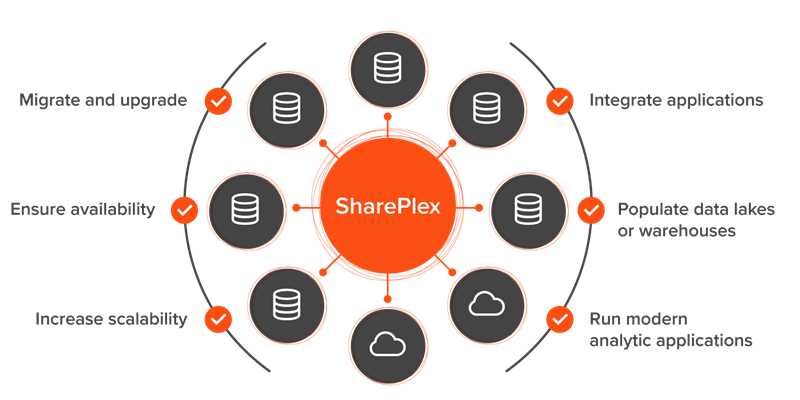
Dynamic data movement involves replicating data from traditional RDBMS systems like Oracle to other databases such as MySQL, Azure SQL Database, Kafka, and PostgreSQL.
Data is the lifeblood of your organization, containing crucial information that drives business operations. The data in your production databases is continuously changing due to factors like customer transactions, sales inquiries, price fluctuations, and purchasing trends. This dynamic data represents the activity that propels your business towards its goals.
Today, a plethora of new techniques and technologies enable business analysts, marketing specialists, salespeople, data scientists, and CXOs to interpret and act on data effectively. However, to maximize data value, it’s essential to ensure real-time data movement between systems.
Understanding Data Movement
Data movement encompasses two key sub-markets:
- Database Replication: Ensures high availability, disaster recovery, and scalability.
- Dynamic Data Movement: Involves the heterogeneous transfer of data between systems.
The core task of data movement is to enhance the value of data by quickly moving it to the right systems.
Traditionally, data replication has been used to achieve this. Replication involves updating copies of your data simultaneously in multiple locations. This process ensures that data is readily available to decision-makers and customers. It also provides high availability, disaster recovery, and scalability beyond the capabilities of a single database.
Most data replication scenarios involve homogeneous environments, such as replicating data from one Oracle database to another. This method is stable, traditional, and familiar.
However, as companies adopt open-source and NoSQL databases, there is a shift from homogeneous replication to dynamic data movement.
What is Dynamic Data Movement?
Dynamic data movement typically applies to heterogeneous contexts and utilizes change data capture (CDC) to transfer data between databases and other systems. It becomes crucial as organizations diversify from traditional enterprise systems like Oracle to new solutions such as MySQL, PostgreSQL, and Kafka. This shift supports common use cases like application integration, populating data lakes or warehouses, and running modern analytic applications.
For instance, in data warehousing, traditional ETL (extract, transform, load) processes are becoming outdated. Data integration requirements have evolved beyond ETL for several reasons:
- Increased Data Volume: The amount of data being processed continues to grow.
- 24/7 Operations: Reduced batch loading windows push towards near-real-time and event-driven data integration.
- Multiple Database Platforms: The trend towards using diverse database platforms results in mismatched sources and targets.
As a result, the data movement market is expanding and overlapping with ETL. Analyst firm IDC categorizes the broader data products market into three groups:
- Data Intelligence: Focuses on data quality management.
- Data Access: Involves connectors, data preparation, and lifecycle management.
- Data Integration: Aims to speed up data delivery for decision-making, including dynamic data movement.
Leveraging SharePlex™ for Data Movement
SharePlex by Quest® simplifies replication across various use cases, ensuring data movement where your business needs it most:
- Availability in Data Replication
- Scalability: Supports distributed processing, cascading, and enhanced performance.
- Reporting and Integration: Facilitates analytics, database consolidation, and low-impact auditing.
SharePlex excels in both homogeneous and heterogeneous environments, making it ideal for dynamic data movement. Common scenarios include:
- Integrating an Oracle operational database with open-source databases.
- Replicating selected data from an Oracle database to open-source databases for data warehousing or reporting.
- Analyzing business data from an Oracle database using cloud tools like Azure Synapse and Azure AI.
With SharePlex, you achieve comprehensive data movement from Oracle to a variety of targets, including SQL Server, Azure SQL Database, Kafka, Azure Event Hubs, MySQL, PostgreSQL, and JMS queues.
As your company grows, you’ll need to move production workloads to the cloud, offload analytics from production databases, and implement disaster recovery strategies. SharePlex allows you to transition from traditional, homogeneous data replication to dynamic data movement without disrupting your customers and users.
About DT Asia
DT Asia began in 2007 with a clear mission to build the market entry for various pioneering IT security solutions from the US, Europe and Israel.
Today, DT Asia is a regional, value-added distributor of cybersecurity solutions providing cutting-edge technologies to key government organisations and top private sector clients including global banks and Fortune 500 companies. We have offices and partners around the Asia Pacific to better understand the markets and deliver localised solutions.
How we help
If you need to know more about dynamic data movement, you’re in the right place, we’re here to help! DTA is Quest Software’s distributor, especially in Singapore and Asia, our technicians have deep experience on the product and relevant technologies you can always trust, we provide this product’s turnkey solutions, including consultation, deployment, and maintenance service.
Click here and here and here to know more: https://dtasiagroup.com/quest/










